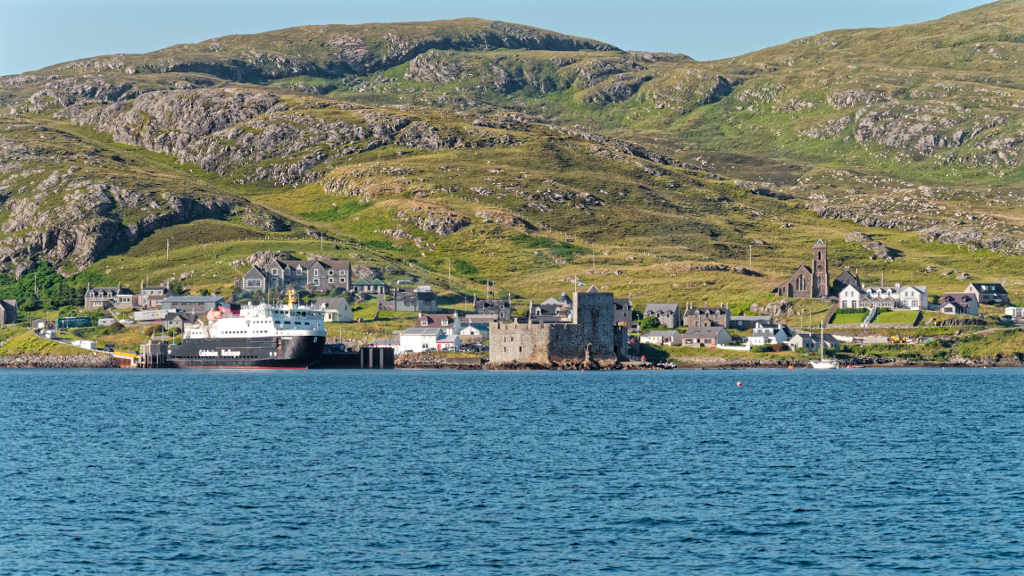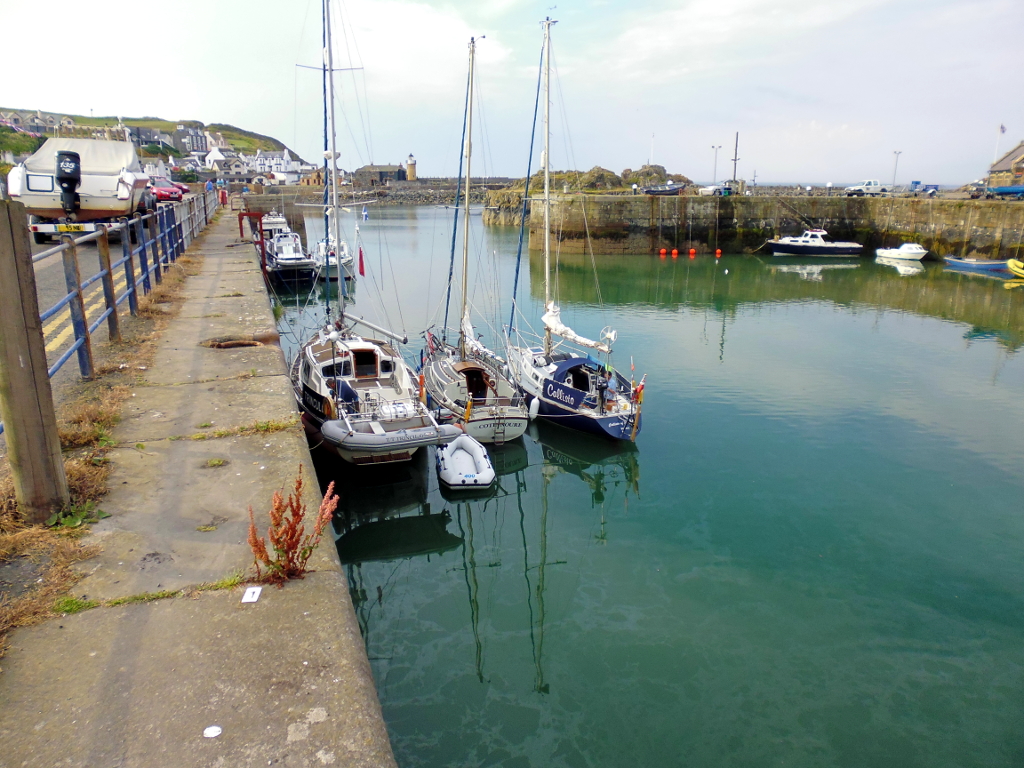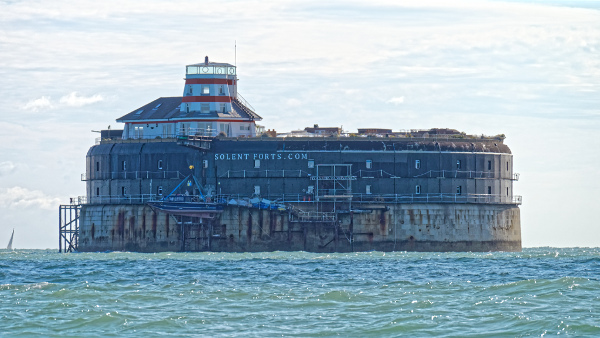The Voyage of Callisto
Two men in a boat - The Hebrides to Lowestoft 2014
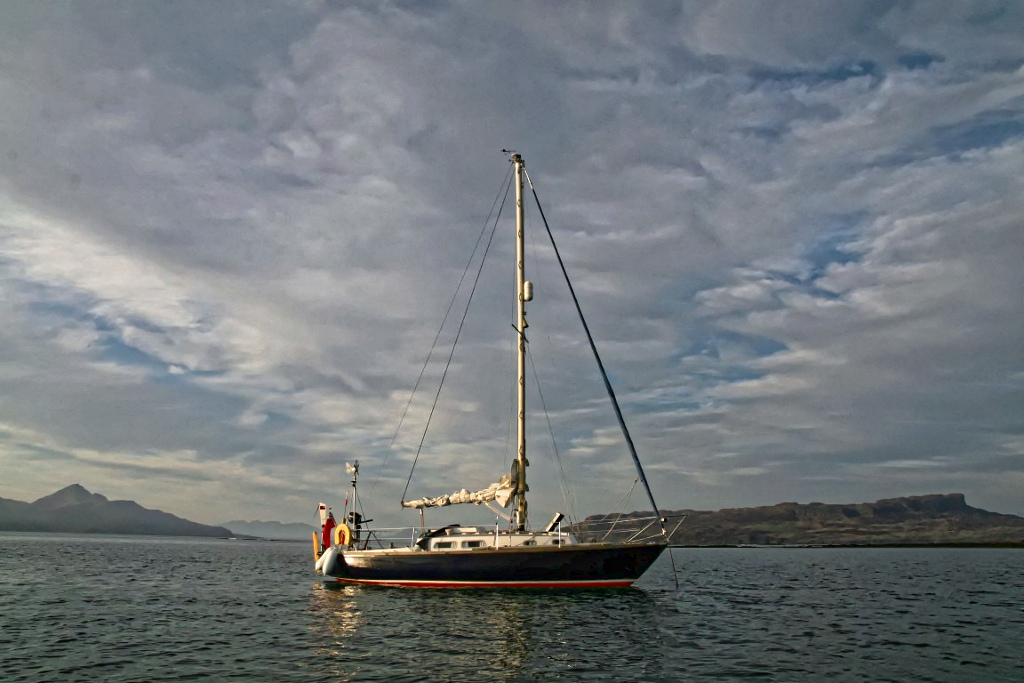
Callisto at anchor in Scotland with the Isle of Eigg in the background
What started as a two week trip to skipper a friend's small 30 foot yacht around the Small Isles and the Inner and Outer Hebrides turned into an epic 2 month, 1,500+ mile, two handed 2/3 circumnavigation of Britain sailing from the Hebrides via Northern Ireland, Eire, Wales, The Isles of Scilly, Cornwall, The Isle of Wight and the South Coast to her new home port of Lowestoft.
We encountered porpoises, a sunfish many, many playful dolphins, swarms of jelly fish, at least 5 Minke whales and a large whale we were too far away from to positively identify but which was blowing huge blowspouts and then breached spectacularly (possibly a Humpback according to a member of the British Antarctic Survey Team we met on our travels!).
We had blistering sunshine, dead calms, large, at times frightening, waves, torrential rain, sudden gale force squalls and an encounter with ex-hurricane Bertha which we raced ahead of from the Isles of Scilly to Falmouth. Our 30 foot, 40 year old, yacht became our own self contained little world seemingly a million miles away from the work-a-day office routine. We moved to the natural rhythm of wind and tides, had to be totally self reliant and the decisions we made potentially really could mean the difference between life and death. More than anything else we took away a wonderful sense of achievement and experiences and memories that will last a lifetime.
Unfortunately, as is often the nature of these things, the circumstances in which we would have been able to take the most spectacular photographs or videos were exactly those circumstances when we were much too busy looking after the boat, and ourselves, to get the camera out (or conditions were too bad for the camera to survive the spray and rain coming over the deck!).
The Journey

Overview of the route sailed by Callisto

Our route in Scotland in more detail
Matt and Jimmy, the owners of Callisto, were relatively inexperienced sailors and had bought Callisto specifically for an extended adventure sailing around the West Coast of Scotland having both decided to take a career break for the purpose. They had been island hopping around the Hebrides for about 3 months when Jimmy had to go back home to deal with some business. As Jimmy was the only one with a sailing qualification sufficient to satisfy the insurance company Matt asked me if I would like to skipper the boat for him for a couple of weeks while Jimmy was away and he would get me added to the insurance policy. Naturally, as we had been talking about me going up for a holiday to sail with Matt and Jimmy for a while anyway, I jumped at the chance. So it was that I Joined the boat at anchor in Arisaig , Scotland, at nearly midnight on Friday the 4th July 2014 after a 14 hour train journey, and a 10 minute ride in the dark in the inflatable dinghy, for what I originally envisaged would be a 2 week trip around The Small Isles and the Hebrides.
Loch nan Ceall, ARISAIG, Inverness Shire (Scotland)

From Callisto at anchor - Having arrived at night in the dark I pop my head out of the hatch and get my first sight of Arisaig in the daylight. The flat topped Isle of Eigg in the background and behind that the Isle of Rum - Absolutely beautiful!

The tricky rock strewn approach to Arisaig is ideal for exploration by kayak or small day boat - The mountain in the far background is the Isle of Skye
Arisaig, Callisto's home port in Scotland, was a lovely spot to start the trip and somewhere I would like to revisit to fully explore with my kayak. To add to the atmosphere the Jacobite steam train, better know to many as the "Hogwarts Express", could be seen steaming through Arisaig from the deck of the yacht. For my first trip in Callisto we sailed across to Loch Scresort on the Isle of Rum to anchor for lunch.
After lunch we headed out again with the intention of sailing to Canna but it soon became apparent that, with a F3-F4 head wind and a strong adverse tide, we weren't going to make much progress tacking between Eigg and Rum so after a pleasant sail we returned to Loch Scresort to anchor for the night ready to catch a favourable tide the next day.

At anchor for the night in Loch Scresort Isle of Rum - A sudden brief evening shower resulted in a beautiful double rainbow
Loch Scresort - Isle of Rum, Inner Hebrides
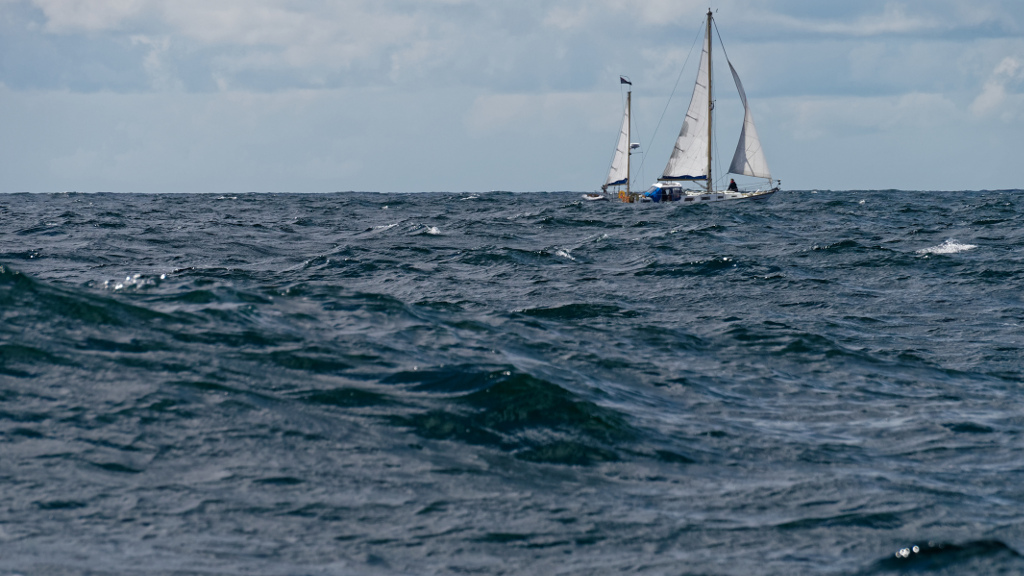
Callisto revels in the windy, choppy, conditions as we overhaul a larger ketch on the way from Rum to Canna. The cabin of the ketch frequently disappearing from view behind the waves
Next morning with Callisto charging along at 7 knots under full sail in a wind of F4-F5 gusting F6 and a lumpy sea we had a hard beat south between Eigg and Rum followed by a fast, exhilarating, reach with beam seas to Canna. This was probably the most enjoyable sailing of the whole trip!
Callisto having a great sail from the Isle of Rum to the Isle of Canna
Isle of Canna, Inner Hebrides
We picked up a visitors buoy on arrival and a quick fishing expedition in the inflatable dinghy around rocks near Canna harbour entrance resulted in some beautiful freshly caught Mackerel for our supper to end a perfect day.
From it's small unattended shop with honesty box to it's single shower on a farm Canna had a rather special feel to it which I was very taken with.
At anchor in Canna - Callisto is the tiny dark hulled dot in the far distance almost centre of photo - Isle of Rum in the background
Isle of Canna on the left, Isle of Sanday on the right
Canna/Sanday beach - Just beautiful, and we had it all to ourselves!
My old Magellan GPS wedged in a wet shoe between the hatch and speaker became our primary navigation device!
By chance, at the last minute when leaving my house to travel to Scotland, I had shoved my old hand held Magellan GPS, complete with a 12v cigarette lighter socket type cable, in my rucksack just in case it was useful. Callisto had a Garmin GPS unit but only below decks at the chart table and with no cockpit repeater so not much help when at the helm. Wedged in a wet shoe between the main hatch and the old defunct radio speaker (sophisticated or what?!) my old Magellan unit turned out to be worth it's weight in gold and became our primary navigation aid. Once programmed with way points for each route, which we plotted by hand on the paper charts first, it gave us readouts of speed, distance and bearing to steer and, very usefully, a screen which showed cross track error (how far off our intended course we were) and which way to steer to get back on course. We of course always logged our position, speed, course, etc diligently in a paper log at regular intervals in case of electronics failure but that little GPS never let us down once and made life much easier especially when helming alone at night.
From Canna we crossed the sea of the Hebrides heading for Castlebay on Barra in the Outer Hebrides and I saw my first ever whale(s) in the wild - A bucket list tick!
We saw 5 Minke Whales on the crossing from Canna to Barra but only managed to get this brief glimpse actually on video (Poor quality)
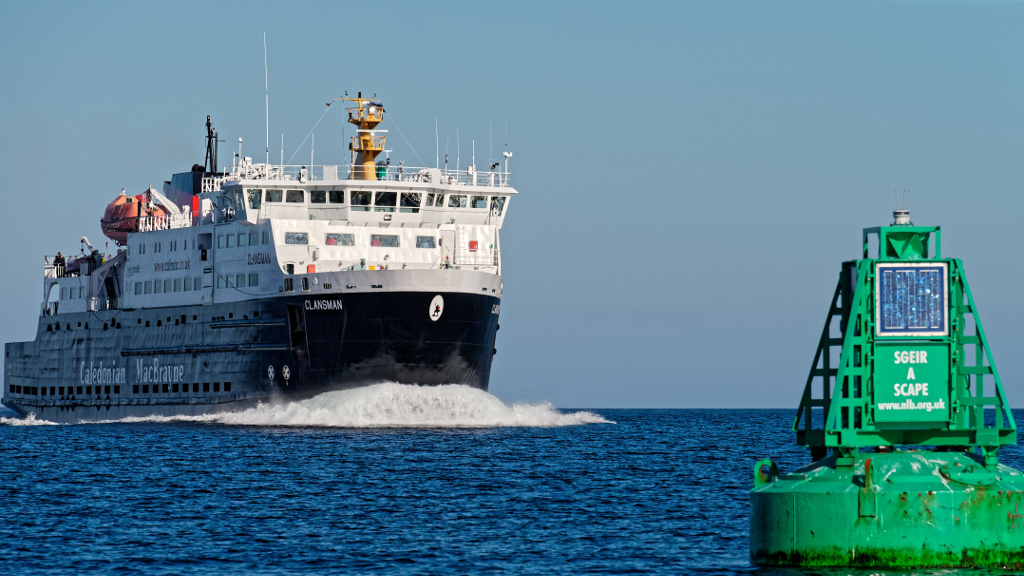
We hide behind the starboard channel marker buoy entering Castlebay as the Cal-Mac ferry rushes by pushing a mountain of water twice as high as our cabin roof in front of it - Now brace for the wash!
Having crossed the sea of the Hebrides from Canna in a little under 12 hours, spotting 5 Minke whales, 2 pods of dolphins and what may have been the fin of a Basking Shark, as well as carrying out several man-overboard and recovery and 3 point fix practices, we arrived in
Castlebay on the Isle of Barra (Outer Hebrides)
The view as we sailed into Castlebay, Barra, in the Outer Hebrides (with the Cal-Mac ferry already docked)
Next day we had a slow 4 hour hop in F1 - F3 winds, meandering a little watching out for whales again, from Castlebay to anchor for the night in nearby
Vatersay Bay (Outer Hebrides)
The next morning from Vatersay Bay, we skirted the Islands of Sandray and Pabbay, went west through the Sound of Mingulay and around Barra Head (the southernmost tip of the outer Hebrides) on Berneray, with nothing now but open Atlantic Ocean on our starboard side for two thousand miles to Newfoundland in Canada. The sheer, towering, cliffs on this atlantic coastline were packed with sea birds and there was a distinctive, slightly ominous, ocean feel to the Atlantic swell we were riding.
Puffins on the Atlantic side of Mingulay
From Barra Head we set course back across The Sea of the Hebrides heading for Tiree. We had a "lively" 13 1/4 hour passage, having to put a large reef in the sail shortly after leaving Barra Head due to the rising wind and increasing wave size and having to leave the reef in for the rest of the day. It was also at this point that Matt, the boat's owner, despite having been living on the boat for over 3 months at this point without ill effect, suddenly discovered that he could be sea sick if conditions were bad enough! However, unlike others I have known who have been totally incapacitated when stricken by seasickness, he stoically battled on, merely putting his head over the side briefly as required while battling to reef sails and tension sheets. Fortunately there was by this time sufficient spray coming over the boat to "clean the decks". Thereafter a couple of further bouts of seasickness on the voyage were a useful barometer indicating conditions were "getting a bit interesting"! Fortunately, although feeling queasy on several occasions, and needing to get my head down in my bunk as soon as I went down below, I managed to maintain my 100% record of never actually being sick on board a boat.
It was also on this leg, when we were about mid Sea of the Hebrides, that I suddenly spotted a blow spout on the horizon. At first I couldn't be sure that I had actually seen it but shortly afterwards there was another one and I had just said to Matt "I think I have just seen a whale blow spout over there" when a very large whale suddenly breached spectacularly. We were too far away to positively identify it but on describing it to a member of the British Antarctic Survey team we met later on an adjoining boat when we were rafted up in Portpatrick Harbour he thought it was most likely to have been a Humpback whale.
Just as we reached Tiree we were met by a sudden, very heavy, rain squall with Force 6 wind and very short, very steep, wind against tide waves that turned Calllisto into a real bucking bronco and nearly stopped us dead in the water as we passed through Gunna Sound to anchor in:
Gott Bay on the Isle of Tiree (Inner Hebrides)
I had been worried, due to the conditions we had met in Gunna Sound, that we might not have enough shelter in Gott Bay to anchor for the night and was contemplating the possibility of pressing on further to Coll but we tucked ourselves into Gott Bay as far as possible and the swell didn't seem too bad so leaving the GPS on with the anchor watch alarm set and with plenty of scope on the anchor chain we gratefully settled in for the night. We had hoped to see Basking Sharks around Tiree and Coll as the area had a reputation for them being plentiful but unfortunately the locals said they just hadn't turned up this year although reading some blogs from the Hebridean Whale and Dolphin Trust later it seems they saw a number of Basking Sharks between Tiree and Vatersay within a few days of our visit. That also makes it more likely that we did actually see a Basking Shark fin on our trip from Canna to Barra.
The next day we had a short passage to
Loch Eartharna on the Isle of Coll (Inner Hebrides)
Where we anchored for the night.
Rounding Ardnamurchan Point on the way back to Arisaig from Coll
Leaving Coll we rounded Ardnamurchan Point, the westernmost point of the UK mainland, and made our way back to
Arisaig, Inverness Shire (Scotland)
We waited in Arisaig for 4 frustrating days for delivery of some new parts for the boat - the most important of which, the new slab reefing kit, did not arrive! This did however give us time to fix the wind generator which had stopped providing power. Fortunately it turned out to just need the brushes removing and the commutator cleaning after which it provided reliable power keeping the batteries nicely topped up for the rest of the voyage. Of course when I say it only needed the brushes removing, as always with boats, this meant several hours trying to remove corroded screws, taking down the mast it was mounted on, cutting and then rejoining wires to allow it to be dismounted, etc, all while trying not to drop pieces overboard as we were still out at anchor.
We frequently saw Harbour Porpoises all the way from Scotland to Dungeness
Not as overtly friendly as dolphins, or prone to aerial acrobatics, nevertheless porpoises (actually a small, toothed, whale) frequently seemed to intersect our track as if just to check us out before nonchalantly carrying on their way. Often we would only be alerted by a snort from their blowholes as they came up behind us (which also explains why Porpoises are sometimes known by the, not very flattering, nickname of "Puffing Pigs").
 Day sail and fishing around the Arisaig/Eigg area
Day sail and fishing around the Arisaig/Eigg area
While waiting for the new parts to arrive we had a visit from Matt's mum and spent a day gently sailing around between Arisaig and Eigg in a very light wind. On the way back into Arisaig Matt and his mum took the opportunity to fish from the dinghy over the rocks while I slowly circled nearby in Callisto. No fish caught for dinner this time unfortunately but what a beautiful setting!

Our last sunset at anchor in Arisaig looking towards the Isles of Eigg and Rum before starting the big journey south
I hope I can revisit one day in both a yacht and a kayak
At this point it became clear that the 3 months island hopping had actually satisfied Jimmy's need for a sailing adventure and he was now keen to get back to his business rather than rejoin the boat. Matt on the other hand was by now fully in tune with the sailing lifestyle and could quite happily have stayed on the boat forever. However, he also wanted to get Callisto to her new home port of Lowestoft before the end of the season when finances dictated he would have to resume his career. It didn't take much persuasion for me to agree to sail Callisto back to Lowestoft with Matt especially as I was a little concerned that with Matt and Jimmy's relative inexperience, even if Jimmy returned to the boat, there was potential for them to get into trouble on some of the extended passages required on such a voyage, sailing out of sight of land in the dark and across busy shipping lanes. Knowing Matt and his determination I also had the suspicion that if I left, and Jimmy didn't return, he might well attempt the voyage single handed anyway. Under these circumstances it seemed to me it would be irresponsible for me to leave Matt and Callisto on their own so I had no choice but to stick with them for the long voyage back to Lowestoft - that's my story anyway and I am sticking to it!
After weighing up various options, calculating times and distances to verify feasibility, and taking into account our preferences to visit the Isles of Scilly and Cornwall we made the
Decision to sail the boat back to Lowestoft via Ireland, the Isles of Scilly, Cornwall and the South Coast
(The long way!)
Up until this point the trip had been pretty idyllic. Having no hard timetables or targets to meet we had sailed leisurely as the fancy took us, not pushing ourselves too hard. Enjoying the seclusion of the Hebrides where we could sometimes sail all day and barely see another boat. Anchoring in bays for free rather than using marinas, sampling Matt's culinary delights (he enjoyed cooking and produced some great meals), often supplemented by food we had caught ourselves. In effect a complete antidote to the modern high stress IT world we had both previously inhabited.
However, the nature of the trip now changed somewhat. With time and financial constraints having to be taken into account, although still wanting to actually stop off and experience places on our way back rather than just sail by, we would have to make a certain mileage every day to stay on schedule including long overnight passages. We would have to sail on some days when otherwise we might have preferred to stay in harbour to avoid the weather and, increasingly the further south we got, negotiate high levels of sailing and shipping traffic and moor in bigger, busier and more expensive marinas. Still enjoyable but more in the style of an endurance challenge than the Lotus-eater lifestyle we had enjoyed in the Hebrides.
Therefore decision made, and having cancelled the remaining part of the non-delivered equipment order in the hope that we could purchase it from a port on our way, we finally set off on our journey southwards from Arisaig with a gentle F2/F3 passage, rounding Ardnamurchan Point once again where we were visited by a seal and a porpoise, to
Tobermory [Balamory!], Isle of Mull (Inner Hebrides)
What's the story in Tobermory! Isle of Mull
There were no pontoon berths available in Tobermory, known to many parents and children as Balamory from the TV series of the same name, so we had to anchor in as close in to the cliff face/trees as we could get and close to a waterfall. Even though we were close in to the shore the water was still over 15 metres deep so we had to use all of the anchor chain we had and it still would not have given us enough scope if it wasn't for the fact that conditions were so calm.
 The Brigantine Lady of Avenel coming in to anchor near us in Tobermory
The Brigantine Lady of Avenel coming in to anchor near us in Tobermory
We left Tobermory after lunch the next day, having had to wait for the tide, and headed for
Oban, Argyll and Bute
or, more properly, the Island of Kerrera opposite Oban arriving in the early evening. We visited Oban the next day using the free water taxi to pick up some more charts and in the chandlers there found, to our relief, the much needed reefing kit for the boat. This now gave us the ability to put up to 3 reefs in the sail quickly, something I was keen to have before embarking on the rest of the voyage. Prior to this, because of broken parts on the old system, we could only have two reefs and even that was a bit of a faff. The new system certainly more than proved it's worth by the end of the voyage!

Pleasant view from the Cockpit in Kerrera Marina - opposite Oban town
Note the wreck marking the drying spit at the marina entrance looking towards the Sound of Kerrera

Oban town seen from Kerrera
The prominent Roman style colosseum is McCaig's Tower built by the wealthy philanthropic banker John Stuart McCaig both as a monument to his family and to provide local employment but unfinished following his death in 1902
Leaving Oban the following day we headed, via the Sound of Luing and the Dorus Mor tide race, for Crinan.

Fladda Island Lighthouse - Sound of Luing

Passing the mouth of the Gulf of Corryvreckan and it's famous whirlpools - The white foaming water appears to be boiling in the distance
Passing the infamous Gulf of Corryvreckan with it's ferocious tides and boiling whirlpools, we elected to take the shortest route to Crinan and, having carefully calculated our tide times, were literally catapulted through the Dorus Mor tide race, which can reach up to 8 knots at it's peak, to
Crinan (and the Crinan canal lock), Argyll and Bute
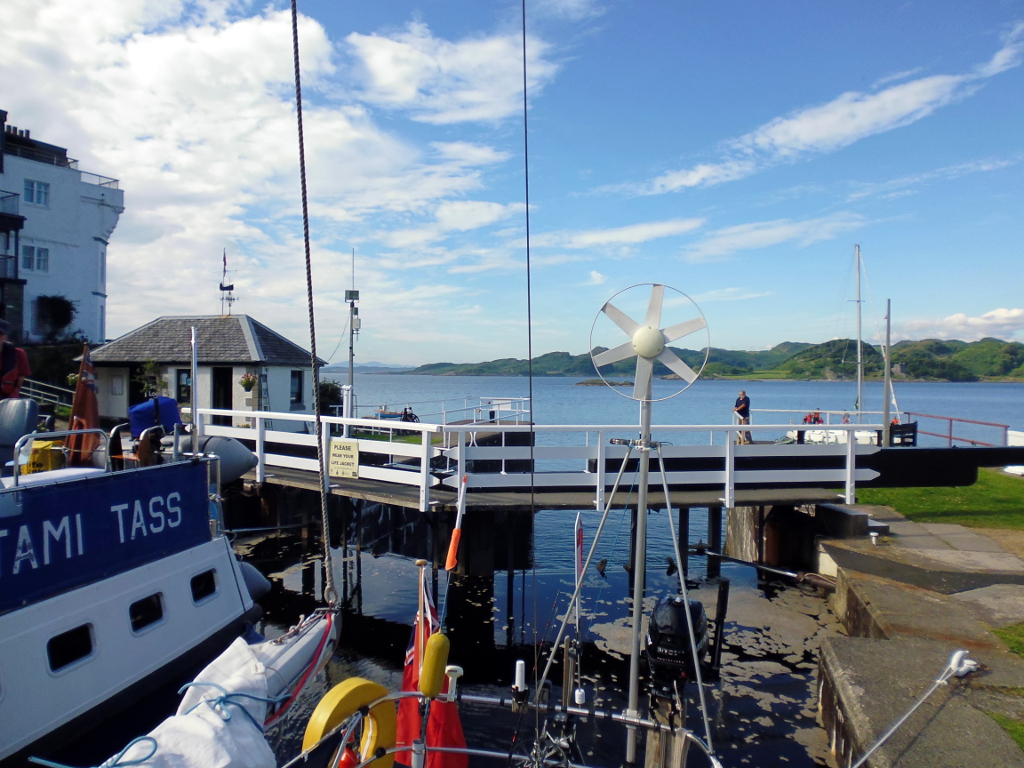 Looking back from the Crinan Canal entrance lock
Looking back from the Crinan Canal entrance lock
It took a day and a bit to travel the 9 miles through the Crinan Canal with it's 15 locks and 7 bridges to Ardrishaig. There was some delay because of a procession of boats participating in the Common Wealth Games celebrations ahead of us. Every lock was nerve-wracking as our vulnerable transom mounted vane steering gear was threatened by the surging boats behind us. If doing the trip again, in settled weather, we would probably choose to sail around the outside of the Kintyre Peninsula and Mull of Kintyre instead.
Ardrishaig (Loch Gilp), Argyll and Bute (Scotland)
From Ardrishaig it was a relief to get the sails up once more and we went on through the Firth of Clyde, leaving the Isle of Arran to starboard. We seemed to encounter some strange anomalies with our steering compass in this area (perhaps caused by the Highland Boundary Fault Line which I have since discovered runs through here) as we headed for
Troon, South Ayrshire (Scotland)
From Troon we passed the distinctively shaped Ailsa Craig and made our way to Portpatrick, visited by a Porpoise on the way.
A sea mist starts to form as we pass the distinctive shape of Ailsa Craig


We were treated to a close up view of the Royal Navy and RNLI practising rescues on the way in to Portpatrick
Approaching Portpatrick - The harbour entrance is there somewhere!
Portpatrick, Dumfries & Galloway - Our last port in Scotland
Rafted up in Portpatrick - Breakfast in the cockpit before leaving Scotland and crossing to Bangor, Northern Ireland
Portpatrick, known to some as the setting for the TV series "Two Thousand Acres of Sky" starring Michelle Collins and Paul Kaye, has a very narrow and hard to find entrance between rocks that you then have to negotiate by using leading marks painted on a couple of buildings in the village, quite hard to locate from seawards and we had to do a couple of passes before we spotted them especially as there seemed to be quite a strong tide pushing us along the coast.
While we were doing this we were treated to a very close up view of a Royal Navy Helicopter and the Lifeboat carrying out rescue practice. As it was getting late when we arrived the small harbour was already fully occupied but we were kindly invited to raft alongside another yacht in the harbour by the crew who immediately invited us to join them in their cockpit to share their beer supplies and some story telling!
 Looking back out through the narrow, rocky, entrance to Portpatrick - Entrance not to be attempted in bad weather
Looking back out through the narrow, rocky, entrance to Portpatrick - Entrance not to be attempted in bad weather
We then bade a sad farewell to Scotland and headed across the North Channel, which connects the Irish Sea to the Atlantic Ocean and, with a F2 - F4 wind, set course for
Bangor - Belfast Lough (Northern Ireland)
The Crossing of the North Channel proved pretty uneventful with fairly light winds and a mild sea although it was little misty as we approached Belfast Lough with an increasing number of larger ships, which always made me nervous, to watch out for as we made our way in to a berth in Bangor Marina where we also spent the next day to give ourselves a break while also doing some passage planning.
Next day, heading south from Bangor, and taking care to avoid the strong tidal streams the sailing instructions mentioned near the entrance to Belfast Lough, we passed the mouth of Strangford Lough and, despite only having a F3-F5 wind, with a strong tide to assist us, were sailing at over 8 knots as we headed for Ardglass.
Ardglass, County Down (Northern Ireland)

The small harbour at Ardglass - Quite shallow at low water
Callisto and Constance (Tom Cunliffe) in Ardglass, Northern Ireland
We moored in the small marina at Ardglass, our last port in Northern Ireland, where we were thrilled to meet sailing guru, author and TV presenter Tom Cunliffe, and his wife, in their lovely boat Constance.
Our first meeting actually came about without us initially realising it as when we got to the small marina office it appeared to be unmanned. Having exited through the door to the outside street we found that the door had locked behind us and it was actually Tom's wife who kindly opened it to let us back into the Marina. Never one to be backward, once Matt had spotted Tom he immediately engaged him in enthusiastic conversation and asked him if he would sign one of his books we had on board while I in the meantime I had gone back to Callisto. Tom said he would be happy to but when Matt got back to the boat it appeared that Tom's books were missing and had probably been taken back ashore. By now a little flustered Matt was wondering whether he could get Tom to sign one of his other books when I pointed out it probably wouldn't be tactful to get Tom to sign a book by another author!
Tom had also mentioned that he thought he had seen us (Callisto) in one of the other marinas (possibly Tobermory?) earlier on our journey. I couldn't help wondering if he had noticed us for all the wrong reasons and maybe we would be cited in a "how not to do " something example in one of his future books or videos! Strangely enough I had seen a figure in the distance at an earlier marina and the thought "is that Tom Cunliffe?" had flashed through my mind but I discounted it as being unlikely and then thought no more about it.
Later while I was sitting in the cockpit, opposite Tom's boat, he actually apologised to me for running his generator in the tiny marina as he had an engineer on board trying to fix a problem with it - Don't worry Tom, we have learned so much from your books and TV programmes over the years, it was one of the highlights of our trip!
It became a standing joke with us thereafter, whenever we were in a sticky situation, to say "Now what would Tom do in a situation like this?" to be followed by 30 minutes of nonsensical banter and very poor impressions of Tom in his instructional videos - Kept us amused though and lightened the mood! A seal also popped up just inches behind our transom while we were moored in the harbour to eyeball us curiously.
In the early evening, from the top of the marina walkway, the hills of the Isle of Man suddenly magically appeared like some mirage clearly visible despite being something like 36 miles away across the sea and not previously in view at all.
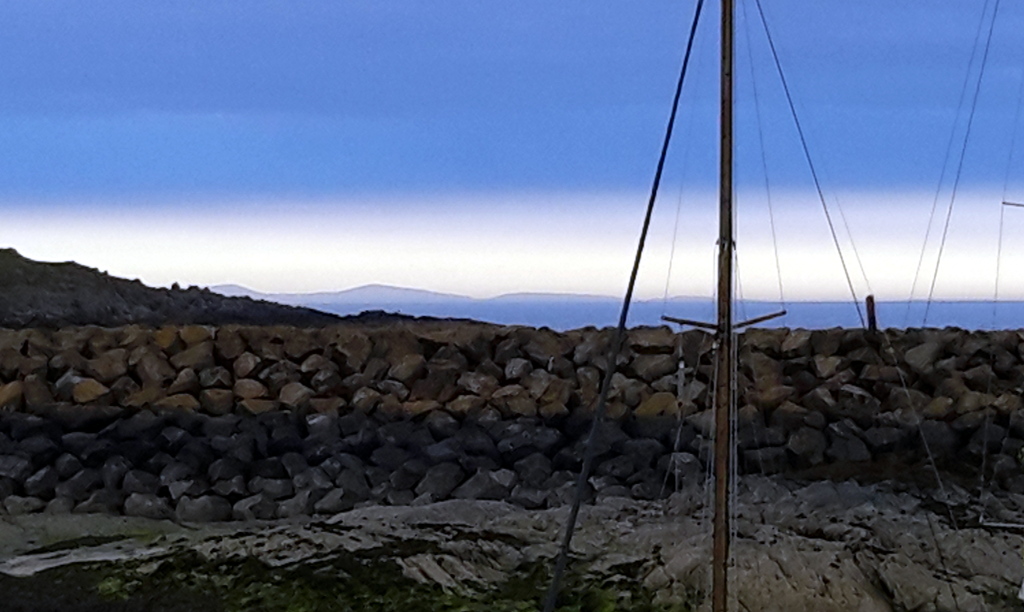
The Isle of Man suddenly appeared clearly visible above the marina wall at Ardglass - Approx 36 miles away
Leaving Ardglass we headed for Howth in Eire and were treated to a spectacular visit from a very large pod of dolphins

The largest pod of dolphins we saw on the trip, 20+, came to play on the way to Howth and completely surrounded us
Video of some of the dolphins we saw en-route - It's not easy filming on a small yacht under sail in waves using a compact camera so please excuse the quality!
We saw many dolphins on our voyage (yet another bucket list tick) and all the way from Scotland to Cornwall it was a very rare day when we didn't encounter at least one pod of dolphins or a porpoise. On the single passage from Ireland to Milford Haven in Wales we were visited by at least 6 pods of both Common and Bottle Nose Dolphins. Sadly from Cornwall onwards to Lowestoft they disappeared and we only saw the odd porpoise.
There is something about dolphins that never fails to lift the spirit. On a couple of occasions when we were feeling down and exhausted, especially after the long night passages, a pod of dolphins suddenly appeared out of nowhere and played alongside us almost as though they could sense we needed cheering up.

That looks ominous! Moments later between Ardglass and Howth A Force 7 squall suddenly hit us and laid us flat
During the passage to Howth we went from pootling along under full sail in a gentle Force 2 to sailing hard pressed even under a double reefed main and genoa recording a maximum speed of 8.2 knots after being very sudddenly hit by a Force 6/7 squall which came out of nowhere, subsequently whipping up quite a choppy sea, and laid us flat. We hastily rounded up, sails flogging noisily adding more drama to the moment, and put the reefs in. I had never before experienced such a sudden large and dramatic increase in wind speed, Katabatic wind off the mountains perhaps?
Proudly flying the Eire courtesy flag at the cross trees we "went foreign" as we crossed the border to a new country, Eire, and had to get used to using Euros as currency!
Howth, Dublin (Eire)
Having had a long, hard, sail the day before we gave ourselves a rest day in Howth and took the opportunity to jump on the DART (Dublin Area Rapid Transit) train for the 20 minute trip to visit the centre of Dublin.
The Tall Ship Jeanie Johnston and the Samuel Beckett Bridge over the River Liffey in Dublin
The Temple Bar in Temple Bar Dublin
Inevitably, after some sight seeing and standing on several of the bridges over the famous River Liffey, we ended up spending a very pleasant afternoon sampling the Guinness in the iconic Temple Bar - well, you have to, don't you! As the bar got more crowded (i.e packed solid) as the afternoon progressed we ended up sharing our table with three very pleasant young American ladies (Ali, Britney and their Aunt Kim - Ladies, if you stumble across this web site, we never did receive the souvenir group photo you took!) who were on something of a European tour. They said they could listen to our accents all day (we thought they had the accents!) which was lucky as they kindly endured our Guiness fuelled ramblings about our voyage and philosophies of life, the universe and everything! The fortunate side effect of having three very attractive ladies sitting at our table was that we seemed to get more than our fair share of attention from the male waiters in the packed bar, can't think why, so we never suffered from dry glasses! However, time, tide and passsage planning wait for no man so, all too soon, we had to jump back on the DART train and head back to Callisto.
Next day, once again facing a stiff beat in a F4-F6 wind, we headed for the small marina in
Greystones, County Wicklow (Eire)
Leaving Greystones the next day we head towards the Isles of Scilly
Video - Heading out from Greystones towards the Isles of Scilly

We head into the Irish Sea as behind us the sun sets and Eire disappears over the horizon - We won't see land again for 24 hours.
We had intended to go straight from Greystones to the Isles of Scilly but with an adverse wind varying from F2 to F6, and a very tired crew, after already sailing non stop for 30 hours, I deemed it sensible to opt for our nominated diversion port of Milford Haven, a mere 5 more hours away, to break up the journey and give us some much needed rest rather than spend a second night at sea. Matt didn't need much persuasion so after a brief discussion we agreed to the change of course. Fortunately this also meant we would make landfall in Wales so we could claim to have landed in every country in the UK and Ireland on our voyage - Scotland, Northern Ireland, Eire/Southern Ireland, Wales and England.
Even so, by the time we reached the port it was dark again. It may look straightforward in daylight but the port of Milford Haven, because of the oil refineries and tanker ships, lights up like a Christmas tree at night which made finding the correct lights and the small channel and entrance to the lock into the Marina a little interesting especially given our extremely tired state. Fortunately Matt had loaded an "App" on his GPS equipped iPad with a marine chart on it and we were able to follow our route to the Marina, for the last mile or so, in real-time on it in much more detail than our yacht GPS could show which proved to be a very useful aid - The wonders of modern technology!
After an exhausting 35 hour, 160 mile, passage, and having been visited by Dolphins at least 6 times, it was with great relief that we finally arrived in
Milford Haven, Pembrokeshire (Wales)
Having had a day to recuperate, and get our laundry done, we left Milford Haven at 05:45 to get through the Marina lock - we were the only yacht leaving, with some trepidation and the full 3 reefs in the mainsail as we were met by very large, short, seas and strong winds in the Haven entrance, signalled by another brief bout of sea sickness for Matt as he gamely raised the sails, but conditions rapidly improved as we once again set course for the Isles of Scilly.
A massive supertanker we had seen docked and then heard on the radio leaving Milford Haven shortly after us gave us some heart stopping moments when it suddenly changed course and appeared to be heading straight for us but, after a reassuring radio call, it altered it's course back to the north of us.
The wind direction wouldn't let us steer the course we needed to head directly for the Isles of Scilly initally but the weather forecast was for a wind direction change later which I calculated would allow us to creep back up to the original rhumb line and avoid us having to tack, effectively in the wrong direction, to make up sea room to the west.
We had dropped more than 7 miles to the east of our intended course, and I admit I was starting to get a little nervous, when the wind did indeed change and we were able to get slap bang on course as predicted. A nice piece of tactical sailing!
As dusk fell another pod of dolphins joined us as we ploughed at speed through some rough seas manoeuvering round a fishing boat (fishing boats always seemed to head straight for us whichever way we turned!). Sadly these were to be the last dolphins we saw on the trip. Then once again there was nothing on our starboard side but open ocean for two thousand miles to Canada and with the land on our port side out of sight below the horizon in the dark it felt like we were quite alone in the middle of nowhere especially standing solo watches.
In the early hours of the morning there was a large, quite eerie, oily ocean type swell which felt like you were dropping into a deep saucer like depression in the sea before slowly climbing up the sides. In my sleep deprived state my imagination was working overtime and I spooked myself thinking we were being sucked down to the seabed in some kind of developing whirlpool!
After another long, tiring, night a glorious dawn broke to a much calmer sea and we were relieved to see the shapes of the Isles of Scilly appearing on the horizon. Our spirits were immediately lifted and the tribulations of the night forgotten.

Compact camera had trouble focussing through the reflections from the morning light but there is an Ocean Sunfish there - honest!
It was here that we also spotted a single fin flopping about in the water and on closer investigation we could clearly see it was actually a small Ocean Sunfish, surely one of the most ungainly looking fish in the sea. This was something Matt had been hoping we would see, although I also think he was hoping for a bigger specimen.
The Isles of Scilly at last 
Nearly there -The Isles of Scilly
Now all we had to do was follow our carefully plotted course to avoid the rocks and hazards and find our way into Hugh Town. We had elected to take the southerly approach between St Mary's and St Agnes as this had seemed an easier, and possibly less tide constrained, route when we had planned it before leaving Ireland bearing in mind we couldn't be sure what time we would actually arrive. By the time we found an anchorage in the harbour at Hugh Town, 31 hours and 137 miles since leaving Milford Haven, the sky and the sea were bright blue and the temperature was sweltering. We could have been in the Caribbean - Fantastic!
Hugh Town, St Mary's Isles of Scilly (England)
A subtropical paradise and a very welcome sight.
View from our anchorage in St Mary's, Isles of Scilly, with the trees of the Isle of Tresco in the background
and the Falmouth Sail Training Ship Hardiesse (a 50' Ferro-Cement ketch) in the foreground.
We would have liked to stay a few days to explore the Isles of Scilly but unfortunately the weather forecast warned of the approach of Ex-Hurricane Bertha and as there was no guaranteed refuge for Callisto on the Isles, and at that time nobody knew just how serious the storm would be when it hit, we had to weigh up our options. One local recommendation was to take any valuables off Callisto, batten down the hatches and camp on the beach until the storm passed leaving Callisto to fend for herself. Our other option was to run for Falmouth and hope we got there before the storm arrived.
In the end we couldn't find it in our hearts to abandon Callisto to her fate and, carefully studying the weather forecasts, calculated that we just had time to get to Falmouth and, if the worst came to the worst, as the storm was coming in behind us we could run eastwards before the storm, under bare poles if necessary, until we could get some shelter from the lee of Lizard Point (The southernmost point of mainland UK) when turning north for Falmouth.

St. Anthony's Light (Fraggle Rock!) and entrance to Falmouth Harbour under some rather forbidding dark clouds
Just to be safe we called up the Coastguard on the VHF radio as we left the Isles of Scilly and informed them of our plan and said we would let them know when we arrived at Falmouth (just in case we went missing!). As it turned out we had a good, albeit somewhat nerve-wracking (everytime a stronger than normal gust hit we thought the storm had caught us!), 12 1/2 hour, 66 mile, passage to Falmouth with no more than a Force 5 wind. By the time the storm actually arrived we were safely tucked up in probably the most sheltered berth in Port Pendennis Marina.
The Marina staff kindly found us the sole spare berth inside the courtyard of the luxury private apartment development with a concrete cill between us and the sea and with the houses higher than our mast protecting us from the worst of the wind! What's more, as it was Falmouth regatta week, we had live entertainment and a drinks tent within 100 yards of us. We could actually hear the bands playing without even leaving the boat. There are much worse places to spend 3 days storm bound! Besides which, Falmouth is one of my favourite places.
Falmouth, Cornwall (England)
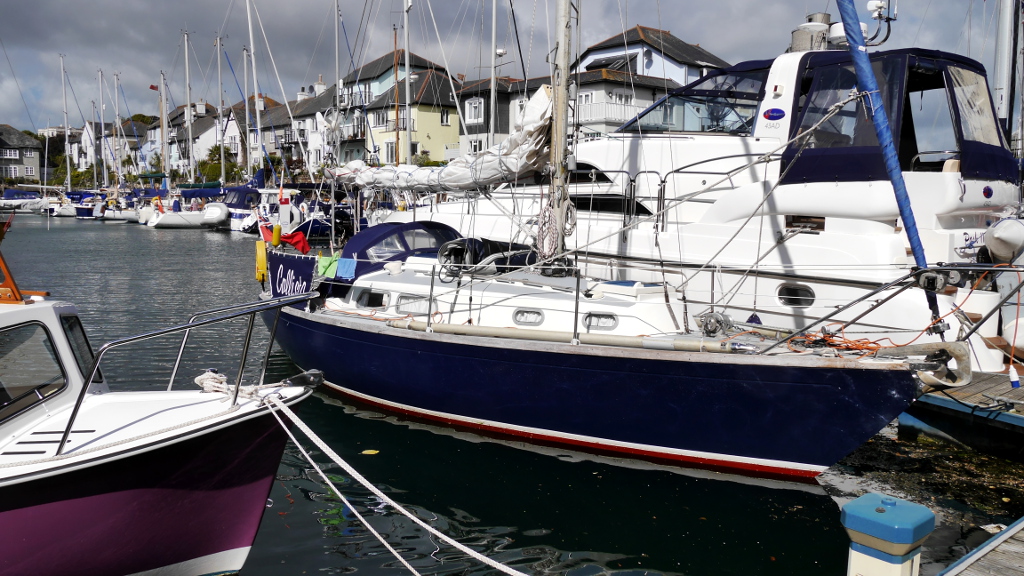 Callisto safely tucked up in Port Pendennis Marina as Ex-Hurricane Bertha passes
Callisto safely tucked up in Port Pendennis Marina as Ex-Hurricane Bertha passes
After 3 days in Falmouth, we decided to make the short hop over to the Helford River although the remnants of the storm were still around and we had an F4 gusting F6 with heavy rain squalls blowing through now and again. Leaving our berth in the small courtyard basin ended up requiring me to do a rather nerve wracking 360 degree pirouette as Callisto, as usual, refused to steer in reverse (her one Achilles' heel) and the strong gusts of adverse wind took her bows downwind (opposite to the direction we actually wanted to turn) before she built up steerage way. Knowing that it would be a losing battle trying to get Callisto to turn to port, the way we actually wanted to go, and that we would end up being blown onto the downwind boats before she turned I instead used her natural tendency to turn to starboard under power so with quite brutal short bursts of forward and reverse engine revs I used the "prop walk" effect to turn her completely around to starboard practically on the spot. With the owners of boats both sides of the basin sitting in their cockpits nervously observing I could feel the sweat building up as I manoeuvred her within inches of their precious boats. With a great deal of relief, and an inner glow of satisfaction, I managed to turn her all the way round until we were facing the basin exit which elicited a spontaneous round of applause from the other boats! The owner of Callisto has told me that to this day he is still amazed at how I managed to get her to turn around without touching the other boats!
 |
 |
| Now you see it - Now you don't - as another sudden squall from the remnants of ex-hurricane Bertha sweeps down the Helford River | |
The Helford River and French man's Creek, Cornwall
While moored in the Helford River we decided to treat ourselves to a pub lunch and ordered the fresh Mackerel. However, having been spoilt by our self caught large juicy mackerel while up in Scotland we were disappointed to find a fairly meagre portion on our plates. So much so in fact that after eating it we immediately ordered a second one each! Don't think this is typical of Cornish mackerel though as, having caught many myself in the past when living in Mevagissey, I can vouch for the fact that Cornish Mackerel can be the equal of their Scottish cousins! We also took the opportunity to travel up river a little way in the dinghy to revisit some of my old Cornish haunts along Polwheveral Creek.
The next morning we set off for Fowey in a gentle F2 which was gradually increasing. I had a little nostalgic moment as I saw Mevagissey, my one time home village, in the distance. A Force 6 squall, with rain, hit us just before we reached Fowey but, as we were on a broad reach, we left full sail up and fairly screamed into the port leaving another small yacht who had been behind us well in our wake.
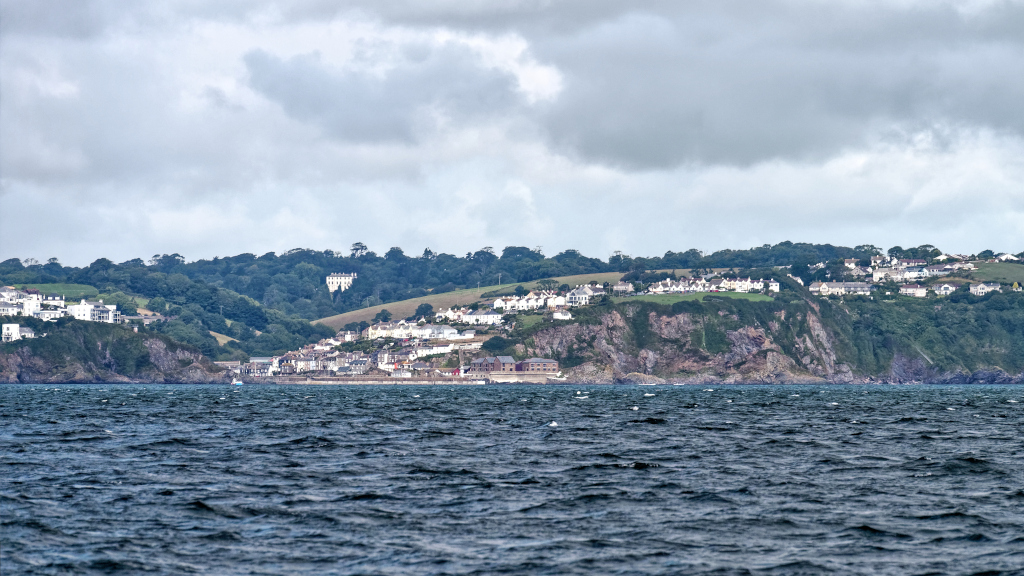
I have a moment of nostalgia as we pass my one time home village of Mevagissey and try to spot my old house

Polruan to the left and Fowey to the right (The sunny side vs the money side according to one local saying!)
We picked up a visitors buoy just off Toms Boatyard on the Polruan side and hailed the water taxi to explore another of my favourite Cornish ports.
Fowey, Cornwall
And then, au revoir my beloved Cornwall, we headed for Dartmouth in Devon leaving Plymouth to Port and the Eddystone Lighthouse to Starboard
On our Starboard side the Eddystone Lighthouse about 12 miles offshore from Plymouth on the way to Dartmouth

And on our Port side Plymouth, Devon - The red and white striped Smeaton's Tower visible on Plymouth Hoe.
Smeaton's Tower was an earlier Eddystone lighthouse. The top section removed and rebuilt on the Hoe in c.1882
Rounding Start Point
64 years earlier my father had used this same waypoint when flying out to Malaya to join 84 Squadron flying Bristol Brigands at RAF Tengah

We meet the coal fired paddle steamer "Kingswear Castle" on a tourist trip as we near the narrow entrance to Dartmouth
Dartmouth (Devon)
Leaving Dartmouth at dawn, to catch a favourable tide round the dreaded Bill, we set off for Portland. We had a fast and bumpy ride and although it started with us almost drifting in a F1 it ended with a hard beat into Portland in F6 gusting F7 having successfully rounded the infamous Portland Bill, the Cape Horn of the South Coast, and it's dreaded tidal race

Rounding Portland Bill with it's notorious tidal race and overfalls
Portland (Dorset)
From Portland we headed for that Mecca of sailing, Cowes, on the Isle of Wight.
Between Portland and the Isle of Wight are St. Adhelms Head and Anvil Point preventing you from travelling the shortest route in a straight line. Tide races and overfalls (areas of steep breaking seas) form off these points so it is best to keep well offshore to avoid these areas which adds even more distance to the journey. The pilot books state that it is possible to avoid these danger areas by staying inshore and effectively going through a narrow gap of calmer water between the overfalls and headlands. We planned to take advantage of this shortcut.
However as we got closer to the headlands we started encountering large steep seas which were lifting Callisto up causing her to broach sideways on the waves as the rudder lost grip on the water. This was getting progressively worse and more uncomfortable. I had already ensured the washboards were in place in the hatchway and the hatch pulled over to prevent water flooding down below should anything untoward happen. Then we were picked up by a particularly large semi breaking wave and laid almost horizontally on our side as I waited for the rudder to grip again and Callisto to respond to the helm and right herself with me encouraging her shouting "Come on girl, come back up."! You know you are heeled pretty far over when you find yourself standing on what is normally the vertical face of the seat opposite!
At this point I decided discretion was the better part of valour. There is no sense in pushing on into potential danger just to save some time, if in doubt do the safest thing. We might have found calmer water had we gone even closer inshore but, not having local knowledge, I didn't like the idea of going closer in and just finding it no better while now being trapped between waves and cliffs. Instead we went about and headed about five miles offshore to make sure we were well outside the tide race and overfalls and accepted the extra hour or so added to the journey. Later that evening Matt confessed that, as Callisto went horizontal, he thought he had lost his boat! I never doubted her for a minute!

Rough and confused seas as we approach The Needles, Isle of Wight
Very rough at times on the passage from Portland with some nasty, breaking, following seas giving us a few heart stopping moments and, just when you think you are nearly there, a rough and not very welcoming Needles Channel!
 Looking back at the iconic Needles as we enter the calmer waters of the Solent.
Looking back at the iconic Needles as we enter the calmer waters of the Solent.
If you look closely on the horizon to the right of the Needles lighthouse in the photo above you can see what looks like a line of surf marking the rough water we came through. This area, near "The Bridge", is notorious for steep rough seas especially in strong wind against tide situations. Many vessels have come to grief here, sometimes with tragic consequences, so it's not a place to take lightly and often best completely avoided in bad weather.
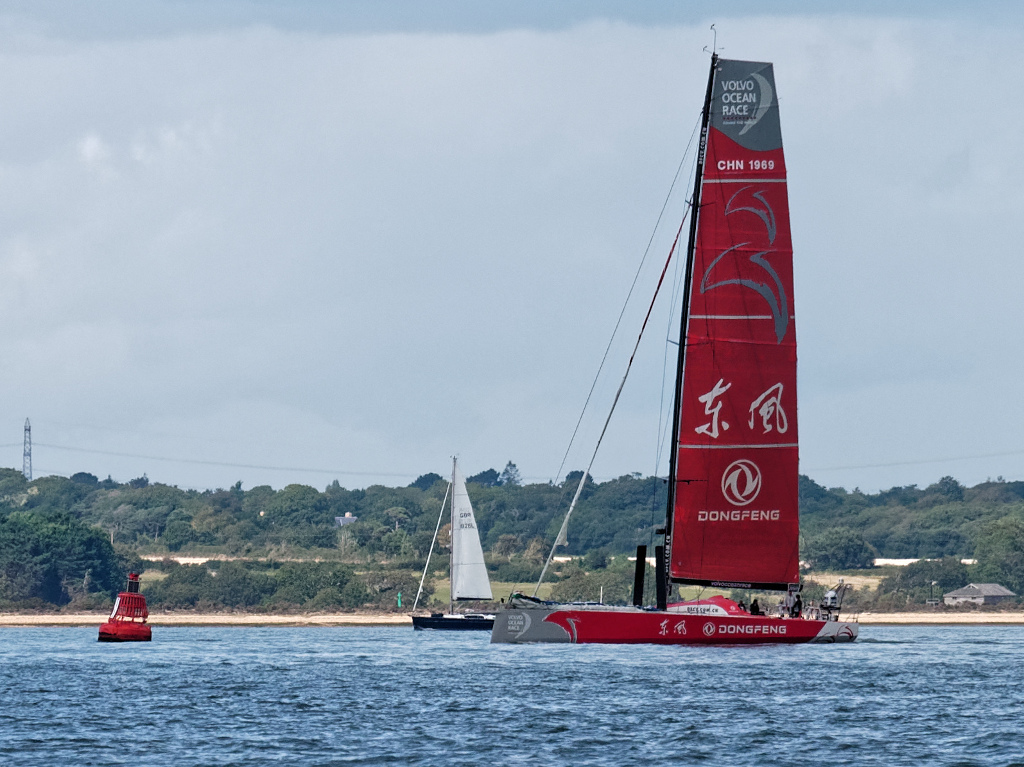
We see the Volvo 65 Round The World Racing Yacht Dongfeng as we enter the Solent
Once through the Needles Channel though, and into the Solent itself, it was suddenly like sailing into an oasis of calm as we sailed past the Volvo 65 racing yacht Dongfeng!
We didn't know it at the time but Dongfeng would go on to be the yacht that a celebrity team from BBC TV's "The One Show" sailed "#hellonhighseas", by coincidence on a very similar route to ours but much faster, from Belfast to London in aid of the charity "Sports Relief" in March 2016. Watching the progress of the team, including their encounter with dolphins, brought back many memories of our own trip and they even read out a "Tweet" of mine to them on the TV!
Dodging the ferries and other marine traffic and having found a berth in a marina at Cowes we ventured into the town for a well earned drink and meal in a local pub where we were quite amused by listening to the loud, I'm afraid very stereotypical, Hooray Henry types sitting at an adjacent table in their designer apres sail apparel. Well this is Cowes after all!
Cowes (Isle of Wight)
 |
 |
|
|
 |
Next day, dodging the numerous massive container ships, ferries and high speed hovercraft and passing Spinnaker Tower and No Man's Land Fort we headed out of a choppy Solent on course for
Brighton, East Sussex
From Brighton we had a nice short passage to Eastbourne. Despite our unpleasant experience last time we tried an inshore passage to avoid overfalls, as the weather was much quieter this time, we again took a chance to hug the coast. This time it was to go inside any overfalls around Beachy Head and were rewarded with a very smooth easy passage and a fine view of another iconic landmark.
![]()
Passing Beacon Mill, Rottingdean, Sussex while on the short passage from Brighton to Eastbourne
With settled weather we risk taking the inshore passage, to avoid the tidal overfalls, and take the shortest route around the iconic Beachy Head!
 A less often seen view of Beachy Head Lighthouse - We kept a close eye on the depth sounder!
A less often seen view of Beachy Head Lighthouse - We kept a close eye on the depth sounder!
Eastbourne, East Sussex
From Eastbourne we headed for Dover and we had another day that started with gentle drifting and ended with a windy F6 gusting F7 and very rough sea.
 Dungeness Nuclear Power Station - We saw our last Porpoise of the trip just off here (and no, it didn't have two heads!)
Dungeness Nuclear Power Station - We saw our last Porpoise of the trip just off here (and no, it didn't have two heads!)
It was especially rough near Dover Harbour entrance where there were very nasty reflected seas from the harbour wall meeting the oncoming waves (Clapotis) and we were thrown about, quite violently, while waiting as instructed for a gap in the shipping traffic and clearance to enter from Dover Harbour Control. Once moored in the marina we headed for the nearest local hostelry for a quick refreshment and an evening meal. We only meant to stop briefly as we wanted to get back to the boat to complete our passage planning for the next day but as it turned out there was an excellent live band playing (60's, 70's etc) so by the umpteenth time we had said we'd just stay to hear one more song it was nearly closing time!
Dover, Kent

That's France - It seems very close as we leave Dover and just for a minute we think ... Should we?!
The following day we had an excellent fast sail from Dover to Ramsgate hitting 8.8 knots, with a little tidal assistance, and not being disgraced by the racing fleet taking part in Ramsgate regatta which we met and kept pace with. We resisted the temptation of the French mainland which looked tantalisingly close as we left Dover! As it was regatta week the marina was quite full but fortunately they managed to squeeze us in. Here I'd pre-arranged to meet my parents, who were living in nearby Margate at the time, so I hopped ashore for the afternoon leaving Matt to explore the delights of Ramsgate.
Ramsgate, Kent
We left Ramsgate anticipating it being our penultimate passage as we intended to go to Shotley, opposite Harwich at the confluence of the River Stour and River Orwell, for the night and then, on the following day, make our our final passage to Lowestoft.
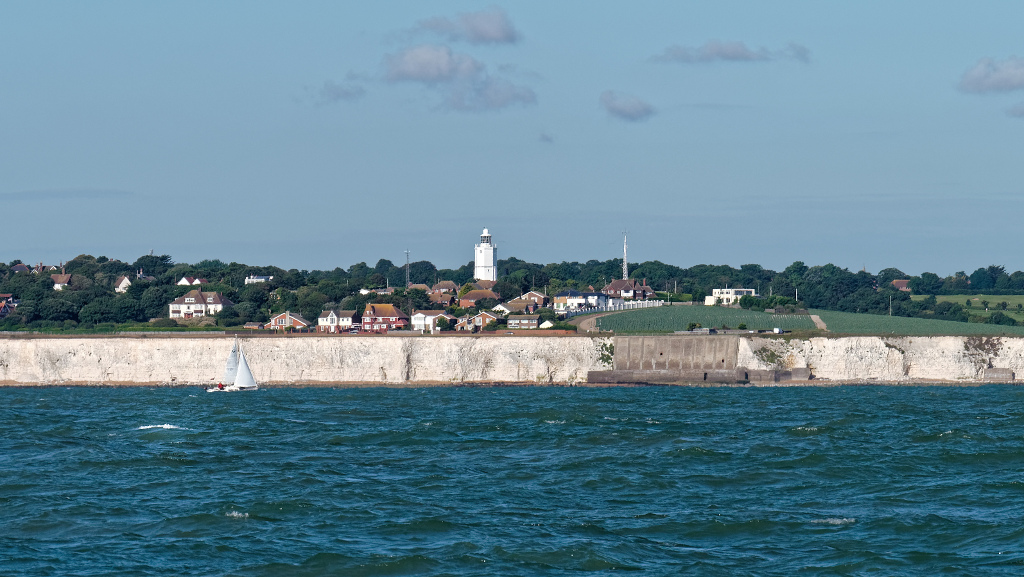 North Foreland Lighthouse
North Foreland Lighthouse
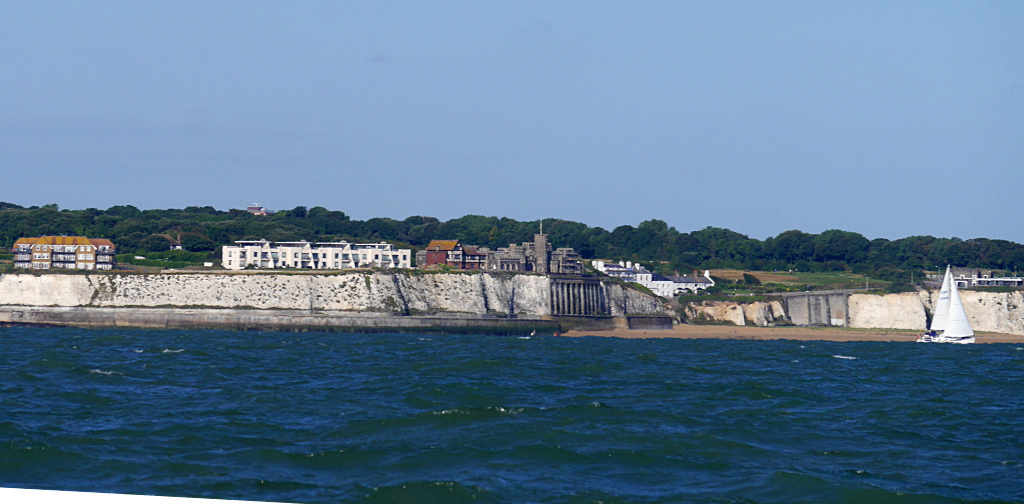 Kingsgate Castle near Margate
Kingsgate Castle near Margate
 Thanet Wind Farm off Margate
Thanet Wind Farm off Margate
As it turned out we made such good progress in reaching the approaches to Harwich that we calculated, with the favourable tide we still had with us, it would only take us a couple of hours more to get to Lowestoft than it would to get to Shotley. Of course these things never quite work out that way and it seemed that the weather decided it was going to give us one more test before we could get home.
 Another Nuclear Power Station - This time Sizewell in Suffolk
Another Nuclear Power Station - This time Sizewell in Suffolk
We did indeed make splendid progress in a stiff breeze with Callisto surging along and crashing through the waves in clouds of white spray in the sort of conditions in which she excelled.
A ship passed us coming the other way and one of the bridge officers came outside to watch us and gave us a cheery wave. No doubt we made a splendid sight and I would have loved to get a photograph of Callisto sailing like this.
At the current rate of progress we reckoned we would be in Lowestoft in about 1 1/2 hours. The weather then decided that we were having it too easy. Very suddenly the wind changed direction meaning we could no longer sail a course directly to Lowestoft and had to start tacking back and forth.
Then heavy rain hit us with F5-F6 squalls. All this time we were losing the tide and it would soon set against us. Then, finally, the wind dropped right off and we were practically drifting with an adverse tide. In the end it took us over 4 more hours to cover the ground to Lowestoft that had originally only been 1 1/2 hours away.
Finally the welcome lights of Lowestoft were in front of us and gently, in the dark, a tiring 14 hours after leaving Ramsgate, we reached our final destination of Lowestoft and slipped into a temporary berth in the outer harbour in a state of quiet elation. We checked with harbour control and they booked us in to go through the Bascule lifting bridge at 11:15 the next morning to make the final short trip up the river to Callisto's new pontoon berth at the marina in Lake Lothing.
Despite the exhaustion we walked into Lowestoft town for a quick celebratory drink and picked up a chinese takeway to eat on the boat before falling into a very peaceful and contented sleep, not quite believing we had actually made it!

14 hours after leaving Ramsgate, and as dusk falls, we see the welcome lights of Lowestoft finally appear
The wind turbine visible in the photo, known as Gulliver and purportedly the tallest wind turbine in the UK, is situated on Ness Point in Lowestoft (Suffolk), the easternmost point of the UK mainland. Our voyage therefore had included the westernmost, southernmost and easternmost points of the UK mainland. We only needed the northernmost (Dunnet Head, Scotland) to make the full set!
23 Aug 2014 21:15 - Lowestoft, we made it!
Arrived Lowestoft Outer Harbour in the dark and near calm after experiencing very strong squalls with heavy rain and bumpy seas on the way.
Casting off at 11:00 the next morning we went through the Bascule Lifting Bridge at 11:15 and then slowly made our way to Callisto's new pontoon berth at the marina in Lake Lothing. At 11:40 on 24 Aug 2014 Callisto arrived at her new berth. The voyage was over!
Tired, emotional, relieved to be back, sad the adventure is over - and just a little bit proud of ourselves!
Mileage : Over 1,320 nautical miles
(approx 1,519 statute/land miles at an average of about 5mph)
52 days on board
Jimmy, the co-owner of the boat, was already waiting for us on the pontoon when we berthed in Lowestoft Yacht Haven. Very quickly our gear was packed into the car and I took one last look at Callisto before suddenly, and unceremoniously, we were heading for home. After over 1,500 miles and more than 50 days on board it felt almost like betraying Callisto to leave her alone on her mooring. It was a real wrench leaving her behind and the elation of our achievement was tinged with more than a little sadness that the adventure was now over.
The novelty of a proper flushing toilet, a long hot shower, that didn't turn itself off when the money ran out after 4 minutes, and an even longer soak luxuriating in the bath on return home soon helped restore my spirits somewhat.
It also meant that I looked slightly more civilised when my family, who had been out when I got back as they had not expected me home for another day, returned. They were, however, somewhat shocked by the full blown, bushy, "Captain Birdseye" style beard I had acquired on the trip, having been clean shaven when I left. I thought it lent me an authentic and authoritative, if not piratical, "Ancient Mariner" type air but apparently they thought I was more akin to the marooned, and deranged, "Ben Gunn"!
 Our 2/3 Circumnavigation of Britain completed and Callisto safely on her new new mooring in Lowestoft!
Our 2/3 Circumnavigation of Britain completed and Callisto safely on her new new mooring in Lowestoft!
Callisto (actually "Callisto of Parkstone"), a 1970's Elizabethan 30 fin keel cruiser/racer, proved to be an excellent sea worthy yacht and looked after us well on the voyage handling everything that was thrown at her. She was particularly reassuring in a blow when her classic fine lines helped her power through the waves when some of her more modern, wide bodied, counterparts may have struggled.
Callisto is a very well travelled boat. I believe her previous owners (experienced world circumnavigators!) had bought her in Brightlingsea and subsequently sailed her from the Humber to Norway before sailing her to Arisaig where she was then based for cruising the West Coast of Scotland. This is where Matt and Jimmy subsequently bought her specifically for an extended sailing adventure. Callisto has therefore, to my knowledge, sailed around almost the whole of the UK mainland in her lifetime. By coincidence, on reading the previous owner's blogs, I discovered that they had at one time ,when cruising in Norfolk in a different yacht, moored their boat a mere 200 yards from my house - It's a small world!
Sadly, with the adventure now over, Matt and Jimmy had to sell Callisto so I never got to sail her again. I believe her new owners were based in Wales so Callisto's adventures continued as she once again set sail for another new home! I am sure she will continue to have adventures and look after her owners for many more years to come and I will always have very fond memories of her. I only wish I could have afforded to buy her myself!
Thank you Callisto for looking after us so well and thanks to Matt (I couldn't have asked for a better sailing companion) and Jimmy, the owners of the boat, for giving me the opportunity of this once in a lifetime experience!!





